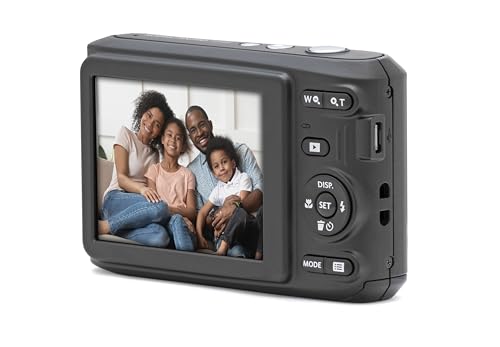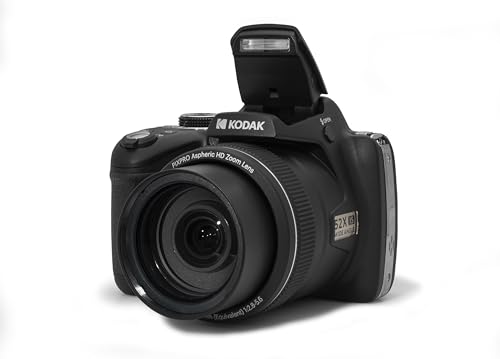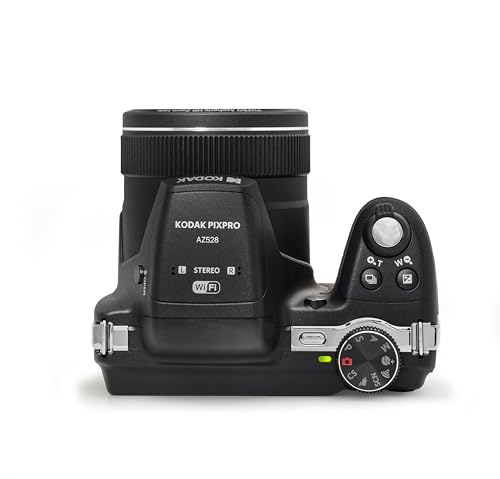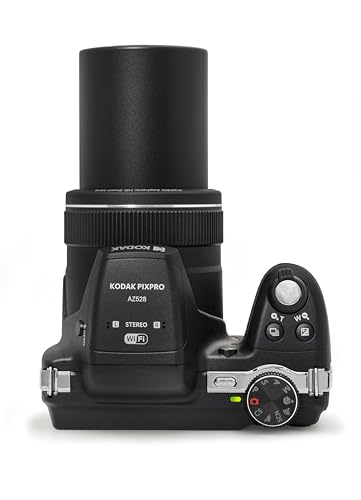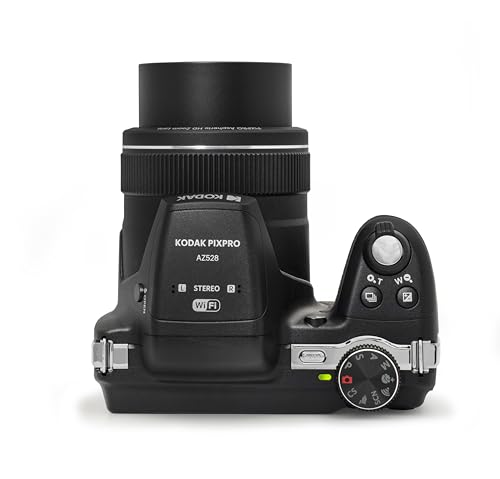




In today’s digital age, cameras have become an essential tool for capturing precious moments and expressing our creativity. With so many options available on the market, it can be overwhelming to choose the best digital camera for your needs. However, there are certain features that stand out and make a camera truly exceptional.
One of the most important features to consider is the image sensor. This is the component that captures the light and turns it into a digital image. A larger sensor size allows for better image quality, especially in low light conditions. Additionally, a higher megapixel count can result in more detailed and high-resolution images. When selecting a digital camera, it is crucial to take into account the type and size of the image sensor.
Another key feature to look for is the camera’s autofocus system. This determines how quickly and accurately the camera can focus on a subject. A fast and reliable autofocus is essential for capturing sharp and well-focused images, particularly when shooting moving subjects or in challenging conditions. Some advanced cameras even offer eye-tracking autofocus, which can be incredibly helpful when photographing people or animals.
Furthermore, the camera’s shooting speed and burst mode capabilities are important factors to consider. The ability to shoot consecutive frames rapidly is especially beneficial for capturing action-packed moments or fast-paced events. A high-speed burst mode ensures that you never miss a decisive moment and allows for creative opportunities such as capturing a fleeting smile or a perfectly timed jump.
Best Digital Camera Features: A Comprehensive Guide to Choosing the Perfect Camera
When it comes to choosing a digital camera, there are several key features that you should consider to ensure that you find the perfect camera for your needs. Whether you’re a professional photographer or just looking to capture some great moments in your everyday life, having the right features can make a big difference in the quality of your photos.
Megapixels: One of the most important features to consider is the number of megapixels the camera has. Megapixels determine the resolution of the photos, with higher megapixels resulting in sharper and more detailed images. While it’s not the only factor to consider, having a higher megapixel count can greatly improve the quality of your photos.
ISO Range: Another important feature to consider is the camera’s ISO range. ISO refers to the camera’s sensitivity to light, and a wider ISO range allows you to capture photos in various lighting conditions. Whether you’re shooting in bright daylight or low-light situations, a wider ISO range will give you more flexibility and better results.
Image Stabilization: Image stabilization is a crucial feature, especially for those who often shoot in fast-paced or shaky environments. This feature helps to reduce blurriness caused by camera shake, resulting in sharper and more clear images. Whether you’re capturing action shots or shooting handheld in low-light situations, having image stabilization can greatly improve the quality of your photos.
Shooting Modes: Different shooting modes can provide you with more creative control over your photos. Whether you’re interested in capturing stunning landscapes, portraits, or action shots, having a camera with a variety of shooting modes can help you achieve the desired effects. Look for cameras that offer a range of modes, including manual mode for full control over all settings.
Video Recording: If you’re interested in shooting videos, it’s important to consider the camera’s video recording capabilities. Look for cameras that offer high-resolution video recording, along with features like manual exposure control and external microphone inputs for better audio quality. Whether you’re capturing vacation memories or filming professional videos, having a camera with good video features can greatly enhance your recording experience.
Connectivity Options: Finally, consider the camera’s connectivity options. Look for cameras that offer Wi-Fi or Bluetooth connectivity, as this allows you to easily transfer your photos to your smartphone or computer for editing and sharing. Some cameras even offer built-in GPS, which can be useful for geotagging your photos and keeping track of where each shot was taken.
By considering these key features and how they align with your specific needs and preferences, you can confidently choose the perfect digital camera to capture all of life’s precious moments.
Image Quality: Understanding the Key Factors that Define Superior Picture Clarity
When it comes to digital cameras, one of the most important aspects to consider is the image quality. As a photography enthusiast, I have spent countless hours exploring and experimenting with different cameras to understand the key factors that define superior picture clarity.
Resolution: The resolution of a camera determines the level of detail that can be captured in an image. Higher resolution cameras typically produce sharper and more detailed photographs. Megapixels play a crucial role in determining the resolution of a camera. The greater the number of megapixels, the higher the resolution and the clearer the image.
Sensor Size: The size of the camera’s image sensor also plays a significant role in image quality. Generally, larger sensors are able to capture more light, resulting in better image quality, especially in low-light conditions. Cameras with larger sensors tend to produce images with less noise and better dynamic range.
- Image Processing: The image processing capabilities of a camera can greatly impact the final image quality. Powerful image processing algorithms can enhance colors, reduce noise, and improve overall image sharpness. Cameras that have advanced image processing features often produce superior picture clarity.
- Optical Quality: The quality of the camera lens and its optical elements also plays a crucial role in determining picture clarity. Lenses with high-quality optics can minimize aberrations and distortions, resulting in sharper and more accurate images. Investing in a camera with a high-quality lens is essential for achieving superior image quality.
- Dynamic Range: Dynamic range refers to the ability of a camera to capture a wide range of tones and details in a single image, from the brightest highlights to the darkest shadows. Cameras with a higher dynamic range can produce images with more depth and detail, showcasing a greater range of colors and tones.
By understanding these key factors that define superior picture clarity, we can make informed decisions when choosing a digital camera. Whether you’re a professional photographer or an amateur enthusiast, investing in a camera that excels in image quality will greatly enhance your photography experience.
Megapixels: Debunking the Myth and Understanding How Many You Really Need
As a photography enthusiast, I’m often asked about the importance of megapixels when it comes to digital cameras. There seems to be a misconception that more megapixels automatically result in better image quality. However, it’s important to debunk this myth and understand the true significance of megapixels.
What are megapixels?
Megapixels, or MP, refer to the number of pixels a camera’s sensor can capture in a single image. The higher the megapixel count, the more detail the camera can capture. This has led many people to believe that a camera with a higher megapixel count will produce sharper and better quality images.
The truth about megapixels
While it’s true that a higher megapixel count can result in more detail, it does not necessarily guarantee better image quality. In fact, the difference in image quality between a 20-megapixel camera and a 10-megapixel camera may not be noticeable in most circumstances. The reason for this is that other factors, such as the camera’s sensor size, lens quality, and image processing capabilities, also play a crucial role in image quality.
How many megapixels do you really need?
The number of megapixels you need depends on your specific photography needs. If you’re a professional photographer who often prints large-sized images or crops extensively, a higher megapixel count may be beneficial. However, for most casual photographers, a camera with around 12 to 16 megapixels is more than sufficient to capture sharp and detailed images, especially when viewed on digital screens or printed in standard sizes.
- In conclusion,
When considering the number of megapixels in a digital camera, it’s important to remember that it is just one factor among many that contribute to image quality. Instead of solely focusing on megapixels, it’s essential to consider the camera’s overall features, such as sensor size, lens quality, and image processing capabilities. Ultimately, choosing the right camera should be based on your specific needs and preferences, rather than solely on a megapixel count.
Autofocus System: Why It Matters and How to Ensure Sharp, Crisp Photos Every Time
As a passionate photographer, I have come to understand the importance of a reliable autofocus system in capturing sharp and crisp photos. The autofocus system of a camera helps in achieving accurate focus quickly, ensuring the subject of the photo is crystal clear. Whether you are capturing fast-paced action shots or shooting in low light conditions, a great autofocus system makes a significant difference in the outcome of your photographs.
There are several factors to consider to ensure that your autofocus system delivers the desired results. Firstly, it is important to select the appropriate autofocus mode for the specific shooting scenario. Many cameras offer multiple autofocus modes, such as single-point autofocus, continuous autofocus, and automatic autofocus. Understanding the strengths and limitations of each mode will help you choose the most suitable one for your subject and environment.
In addition to selecting the right autofocus mode, it is also crucial to understand how your camera’s autofocus points work. Most digital cameras feature a grid of autofocus points that cover various areas within the frame. By selecting the autofocus point directly on the subject or using the camera’s tracking feature to follow the subject, you can achieve precise focus and avoid any blurring or softness in the final image.
Furthermore, keeping your camera’s autofocus system up to date through firmware updates is essential. Camera manufacturers often release firmware updates that improve autofocus performance and add new features. Regularly checking for and installing these updates will ensure that you have access to the latest autofocus capabilities of your camera.
In conclusion, a reliable autofocus system is a must-have for any photographer who wants to capture sharp, crisp photos consistently. Understanding the different autofocus modes, utilizing the correct autofocus points, and keeping your camera’s firmware up to date will help you achieve the best possible autofocus performance and enhance the overall quality of your photographs.
Low Light Performance: Discovering the Cameras with Exceptional Sensitivity to Capture Stunning Shots in the Dark
When it comes to photography, capturing stunning shots in low light conditions can often be a challenge. However, with the advancement of technology, digital cameras are now equipped with exceptional features that allow for high sensitivity in low light settings. These cameras are capable of capturing mesmerizing images in the dark, opening up a whole new world of possibilities for photographers.
One of the key features to look for in a camera with exceptional low light performance is its ISO range. ISO determines the camera’s sensitivity to light, and a higher ISO value allows for better image quality in low light conditions. Look for cameras with a wide ISO range, such as ISO 100 to 25600 or even higher, as this will give you the flexibility to capture stunning shots in various lighting situations.
- Noise Reduction: Another crucial factor to consider is the camera’s noise reduction capability. When shooting in low light, noise can often be a problem, resulting in grainy and distorted images. Look for cameras that have advanced noise reduction technology, which can effectively minimize noise and produce sharp and clear images even in challenging lighting conditions.
- Image Stabilization: In low light situations, it can be difficult to keep the camera steady, leading to blurred images. Image stabilization is a feature that helps to counteract camera shake and allows for sharper images. Look for cameras with in-body image stabilization or lenses with built-in stabilization to ensure that your shots are crisp and clear, even in dimly lit environments.
- Fast and Wide Aperture: A wide aperture lens allows more light to enter the camera, which is crucial in low light photography. Look for cameras with lenses that have a wide maximum aperture, such as f/1.8, f/1.4, or even wider. This will enable you to capture well-exposed images even in minimal lighting conditions, without having to rely heavily on additional lighting equipment.
- High Dynamic Range (HDR): HDR is a technique that combines multiple images taken at different exposures to create a final image with a wide range of tones. This is particularly useful in low light photography, as it allows you to capture more details in both the highlights and shadows. Look for cameras that offer HDR functionality, either in-camera or through post-processing software, to enhance the quality of your low light shots.
With these exceptional features, capturing stunning shots in the dark is now within reach. Whether you’re photographing landscapes, portraits, or night scenes, a camera with exceptional low light performance will allow you to unleash your creativity and capture breathtaking images that were once only possible in daylight.
Burst Mode: Exploring the Benefits of High-Speed Continuous Shooting for Action Photography
As a photographer, capturing the perfect moment is crucial, especially when it comes to action photography. One of the best features to have in a digital camera for this type of photography is burst mode. Burst mode allows you to take a rapid series of photos in quick succession, capturing all the action in real-time. It is an invaluable tool that can make a significant difference in the quality and impact of your action shots.
One of the key benefits of burst mode is the ability to capture fast-moving subjects with precision. Whether you’re photographing a sporting event, wildlife in motion, or any other action-packed scenario, burst mode ensures that you don’t miss a moment. With the high-speed continuous shooting, you can capture a sequence of images, increasing the chances of getting that perfect shot where the subject is in perfect focus and positioned just right.
Burst mode also gives you the flexibility to choose the best image from a series of shots. When you shoot in burst mode, you can review the images afterward and select the frame that has the best composition, expression, or timing. This feature allows you to capture moments that may have been fleeting and choose the shot that best captures the essence of the action.
In addition to capturing fast-paced moments, burst mode can also be used creatively to capture motion blur. By using a slower shutter speed and firing a burst of shots, you can create a sense of movement in your images, adding a dynamic and artistic touch to your action photography. Burst mode opens up endless possibilities for experimentation and capturing unique shots that stand out from the rest.
Overall, burst mode is an essential feature for anyone interested in action photography. It provides the opportunity to capture fast-moving subjects with precision, choose the best image from a series, and experiment with creative techniques. Whether you’re a sports photographer, wildlife enthusiast, or simply enjoy capturing action-packed moments, having burst mode on your digital camera will undoubtedly enhance your photography and help you capture those perfect shots.
Lens Options: From Zoom to Prime, Choosing the Right Lens for Your Photography Style
As a photographer, one of the most important decisions you’ll make is choosing the right lens for your photography style. With the wide range of lens options available, it can be overwhelming to know where to start. From zoom lenses to prime lenses, each type has its own advantages and can greatly impact the outcome of your photos.
Zoom lenses are a popular choice for many photographers due to their versatility. These lenses allow you to zoom in and out, giving you the ability to capture a wide range of focal lengths without changing lenses. This makes them perfect for situations where you need to quickly adjust your framing or capture subjects from a distance. Whether you’re shooting landscapes or capturing action shots, a zoom lens can be a great all-around lens option.
Prime lenses, on the other hand, have a fixed focal length and do not zoom. While this may seem limiting, prime lenses offer incredible image quality and are often faster than zoom lenses, meaning they have a wider maximum aperture. This allows for better low-light performance and creates a beautiful shallow depth of field, making your subject stand out from the background. Prime lenses are popular among portrait photographers and those who value image quality above all else.
When choosing the right lens for your photography style, it’s important to consider the type of photography you primarily engage in. If you often find yourself shooting in different scenarios and need versatility, a zoom lens may be your best bet. However, if you have a specific genre or style you focus on, like portraiture or street photography, a prime lens can provide the image quality and unique look that you desire. Ultimately, it’s all about finding the lens that best suits your needs and allows you to capture the photos you envision.
Connectivity Features: Beyond Wi-Fi – Exploring Cameras with Advanced Sharing and Remote Control Capabilities
The advancements in digital camera technology have revolutionized the way we capture and share our precious moments. While Wi-Fi connectivity has become a standard feature in most digital cameras, there are several advanced connectivity features that go beyond just connecting to a wireless network. These features provide unprecedented convenience and flexibility, enabling users to easily share their photos and videos and even control their cameras remotely.
Advanced Sharing Capabilities:
Modern digital cameras are equipped with a range of connectivity options that allow users to effortlessly share their photos and videos with others. In addition to Wi-Fi, cameras now come with built-in Bluetooth and NFC (Near Field Communication) capabilities. Bluetooth allows for direct and seamless file transfer between the camera and a smartphone, while NFC allows for quick pairing and sharing by simply touching the camera and the smart device together.
Camera models equipped with advanced sharing capabilities also offer compatibility with popular social media platforms, making it effortless to share your content with friends and family. With a few simple taps on the camera’s touchscreen, you can upload your photos and videos directly to social media platforms like Facebook, Instagram, and YouTube.
Remote Control Capabilities:
Some digital cameras now offer remote control capabilities, allowing users to control the camera’s settings and capture photos and videos from a distance. This is especially useful for capturing group photos or taking self-portraits. Remote control can be achieved through various means, including smartphone apps, dedicated remote control devices, or even through a computer.
With remote control capabilities, photographers can easily adjust exposure settings, focus, and even composition without having to physically access the camera. This opens up a whole new world of creative possibilities and allows for capturing shots that were once difficult or impossible to achieve.
In conclusion, advanced sharing and remote control capabilities have taken digital cameras to a new level of convenience and flexibility. With features like Bluetooth, NFC, and compatibility with social media platforms, users can easily share their photos and videos with others. Remote control capabilities further enhance the creative possibilities by enabling photographers to control the camera from a distance. As technology continues to progress, we can expect even more innovative connectivity features in future digital camera models.
Best digital camera features
Features
| Part Number | FZ45BK |
| Model | FZ45BK |
| Warranty | Limited 1-Year Warranty |
| Color | Black |
| Release Date | 2022-10-03T00:00:01Z |
| Price history for KODAK PIXPRO FZ45-BK 16MP Digital Camera | |
|---|---|
|
Latest updates:
|
|
Features
| Part Number | 080BK1A |
| Model | 080BK1A |
| Warranty | 1 year |
| Color | Black |
| Release Date | 2025-05-07T00:00:01Z |
| Size | 5K |
Features
| Part Number | DC101 |
| Model | DC101 |
| Warranty | 1 |
| Color | Black |
Features
| Model | W08 |
| Color | YL15-W08-C-Black |
| Is Adult Product |
Features
| Part Number | DC402-AF |
| Model | DC402 |
| Color | White |
| Size | Compact |
Features
| Part Number | 26532 |
| Model | 26532 |
| Warranty | 1 year manufacturer |
| Color | Black |
| Release Date | 2020-02-06T00:00:01Z |
| Price history for Nikon COOLPIX P950 Superzoom Camera | |
|---|---|
|
Latest updates:
|
|
Features
| Part Number | 0819900013856 |
| Model | AZ528-BK |
| Warranty | 1 year manufacturer |
| Color | Black |
| Release Date | 2022-11-13T00:00:01Z |
| Language | English |
| Price history for Kodak PIXPRO AZ528-BK with 52x Zoom | |
|---|---|
|
Latest updates:
|
|
Features
| Part Number | 0570C002 |
| Model | 0570C005AA |
| Warranty | 1 year coverage for parts |
| Color | Black |
| Is Adult Product | |
| Release Date | 2015-05-21T00:00:01Z |
| Size | Lens Only |
| Language | English |
| Publication Date | 2019-06-17T00:00:01Z |
| Price history for Canon EF 50mm f/1.8 STM Lens | |
|---|---|
|
Latest updates:
|
|
Question and answers:
What are some important features to consider when choosing a digital camera?
Some important features to consider when choosing a digital camera include megapixel count, image stabilization, zoom capability, low light performance, and ease of use.
What is the benefit of having a higher megapixel count in a digital camera?
A higher megapixel count allows for more detail and better image quality when capturing photos. It also provides the flexibility to crop and enlarge images without losing too much clarity.
What is image stabilization and why is it important in a digital camera?
Image stabilization helps to reduce blur caused by camera shake, resulting in sharper and clearer photos. It is particularly important when shooting in low light conditions or when using a zoom lens.
What is zoom capability and why is it important in a digital camera?
Zoom capability refers to the camera’s ability to magnify a subject. Optical zoom is preferred over digital zoom as it maintains image quality. A good zoom capability allows you to capture distant subjects without losing detail.
Why is low light performance an important feature in a digital camera?
Low light performance refers to how well a camera can capture photos in dimly lit environments. A camera with good low light performance will produce less noise and retain more detail in low light situations, resulting in better quality photos.





